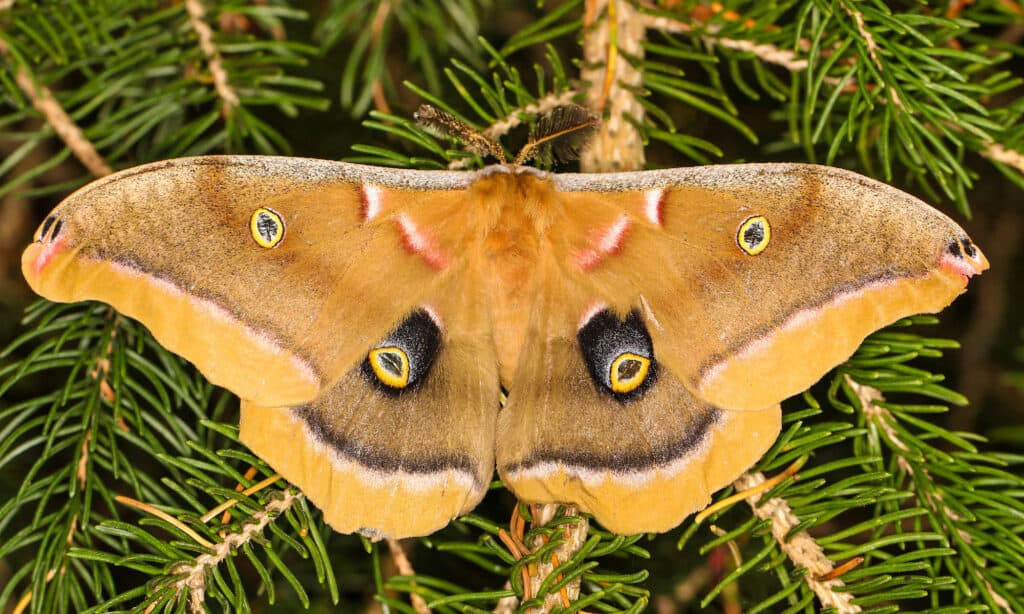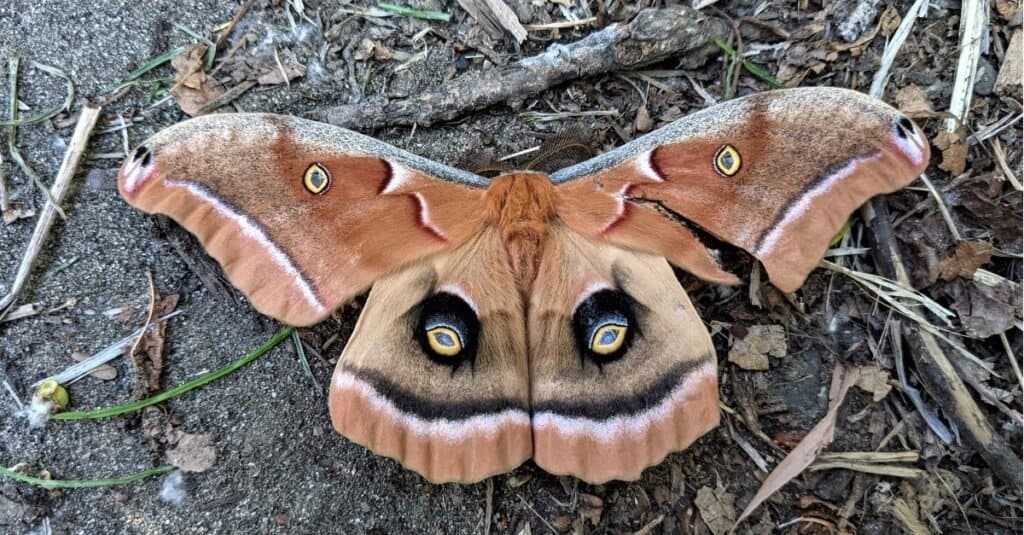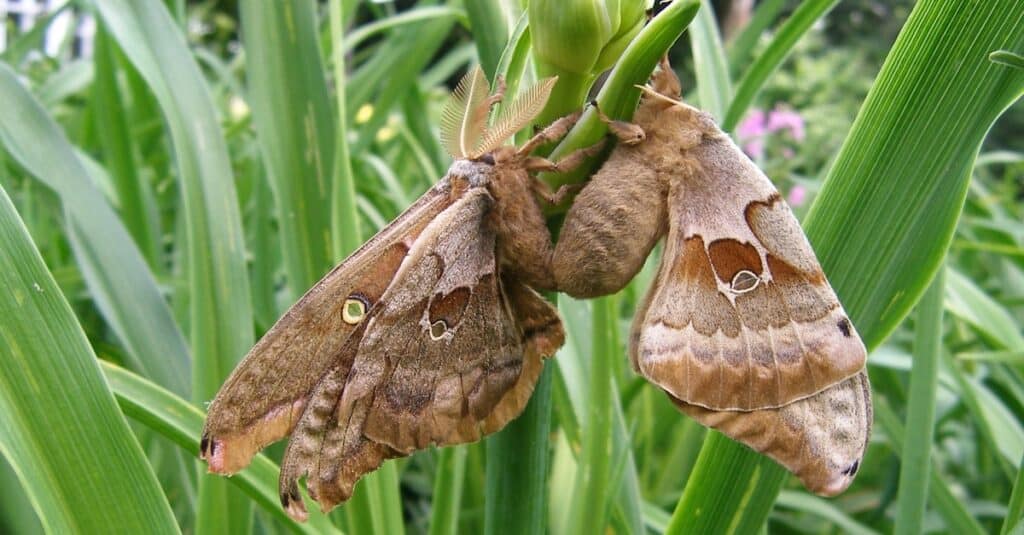Polyphemus Moth
Antheraea polyphemus
The Polyphemus moth doesn’t and can't eat, except when it's a caterpillar!
Advertisement
Polyphemus Moth Scientific Classification
- Kingdom
- Animalia
- Phylum
- Arthropoda
- Class
- Insecta
- Order
- Lepidoptera
- Family
- Saturniidae
- Genus
- Antheraea
- Scientific Name
- Antheraea polyphemus
Read our Complete Guide to Classification of Animals.
Polyphemus Moth Conservation Status
Polyphemus Moth Facts
- Name Of Young
- Larvae, caterpillars
- Group Behavior
- Solitary
- Fun Fact
- The Polyphemus moth doesn’t and can't eat, except when it's a caterpillar!
- Estimated Population Size
- Unknown but possibly millions
- Biggest Threat
- Habitat disturbance, artificial light, predation by squirrels, climate change
- Most Distinctive Feature
- The eyespots on their hindwings
- Gestation Period
- 10 days
- Litter Size
- 1-5 eggs
- Habitat
- Cities, yards, farms, riversides, orchards, bogs, marshes, swamps, forests dominated by hardwoods such as oak, maple and birch
- Predators
- Squirrels, raccoons, mice, woodpeckers, other insects including wasps and ants
- Diet
- Omnivore
- Type
- Moth
- Common Name
- Polyphemus moth
- Number Of Species
- 1
- Location
- Most of the United States, Canada and Mexico
Polyphemus Moth Physical Characteristics
- Color
- Brown
- Purple
- Black-Brown
- Light-Brown
- Skin Type
- Exoskeleton
- Lifespan
- Less than a week as an adult, three months overall
- Length
- 4-6 inches
- Age of Sexual Maturity
- Same day of emerging from cocoons
View all of the Polyphemus Moth images!
The Polyphemus moth is named after a cyclops in Greek mythology.
A member of the Saturniidae family, this large moth is easily recognizable by the eyespots on its wings. These spots are supposed to startle would-be predators when the moth suddenly opens its wings, which should give the moth time to fly to a safer location. However, even if it does get away, the Polyphemus moth only lives about four days or less than a week. Its mouth is vestigial, and its only purpose is to reproduce.

Five Incredible Polyphemus Moth Facts!
Here are some more facts about this fascinating creature:
- The caterpillar makes a clicking sound with its jaws to ward off predators. If that doesn’t work, it vomits.
- Though the moths are nocturnal, they eclose (emerge from the cocoon) in the morning. This gives their wings time to strengthen in the sun.
- Though males can mate a few times, females only mate once. After mating, she spends the rest of her life laying eggs.
- Some people keep Polyphemus moths as pets, though the insects don’t like to breed unless there is a food plant present in their enclosure.
- Male Polyphemus moths can only fly if the temperature is warmer than 44.6 degrees Fahrenheit.

The nocturnal Polyphemus moth emerges during the morning so it can strengthen its wings in the sun.
©iStock.com/BrianLasenby
Scientific Name
The moth’s scientific name is Antheraea polyphemus. The meaning of Antheraea is probably “showy, flowery or brightly colored.” It comes from a New Latin word borrowed from the Greek antheros. In taxonomy, lepidopterans in the Antheraea genus are large moths whose caterpillars produce silk that is used as fabric. Cousins of the Polyphemus moth include the Assam silk moth, the western Polyphemus moth, and the Japanese oak silk moth.
The meaning of polyphemus refers to the cyclops Polyphemus, who kidnapped Odysseus and his men in “The Odyssey” by Homer. He was a giant with a single huge eye in the middle of his forehead. Odysseus managed to put his eye out, and this allowed his crew to escape. Polyphemus’ huge eye, of course, refers to the startling eyespots on the moth’s wings.

A Polyphemus moth is named after the cyclops Polyphemus in “The Odyssey.”
©Cathy Keifer/Shutterstock.com
Evolution and Origins
This moth species was previously known by the New World genus Telea but that genus was combined with the Old World genus Antheraea after scientists determined there were insufficient variations to need a different genus.
The Polyphemus moth belongs to the family Saturniidae, which includes emperor moths, royal moths, and giant silk moths, and is named after the resemblance of the rings around the eyespots to the planet Saturn’s. Although there is no substantial fossil record, based on other data, scientists theorize that the first members of the Saturniidae family originated in the Neotropical region.

The Polyphemus moth belongs to the same family as the Emperor moth.
©iStock.com/imortalcris
Types of Polyphemus Moth
While data is very limited on the types of Polyphemus moth, it’s believed that the moth has a few subspecies, which can be found in different geographical regions. These include:
- Antheraea polyphemus mexicana
- Antheraea polyphemus tuxtlasensis
- Antheraea polyphemus olivacea.
Both Antheraea polyphemus mexicana and Antheraea polyphemus uxtlasensis are found in Mexico. A. p. tuxtlasensis was described in 1994, present in the isolated region of Los Tuxtlas, Veracruz, with morphological differences including yellow ground cover and blue crescent-shaped feature in the eyespot. Due to the wings’ shape and size, it is more closely related to A. p. mexicana than any other subspecies. A. p. olivacea is thought to be in mountainous habitats in Colorado and Utah.
One subspecies, Antheraea polyphemus oculea, was recognized as a separate species of the western Polyphemus moth (Antheraea oculea) in the 1990s. This moth can be found in Arizona and western New Mexico and has a darker color and more markings around its eyespots.

The Polyphemus moth has a few subspecies, two of which are found in Mexico.
©iStock.com/Mickilu
Appearance and Behavior
The Polyphemus moth is one of the most identifiable of the silk moths. It is a giant moth with a 4 to 6-inch wingspan. It could be mistaken for a butterfly until a person takes a closer look. The ground colors of the wings range from yellow to a deep cinnamon brown, and there’s a red margin near the base of the animal’s forewings and two dark patches right at the tips of the forewings.
But what makes the moth easy to identify are the eyespots. The eyespots on the forewings are small and transparent, but the eyespots on the hindwings are large and purplish with a lemon-colored and lemon-shaped patch inside of them. The antennae of the males are deeply feathered. The antennae of the female are less feathered, and she is plumper because of her eggs.
Of course, the Antheraea polyphemus is a caterpillar before it is a moth. After hatching from a tiny egg that resembles a camera battery except it is light brown with two brown bands around it, the caterpillar is black and white striped, rather like a zebra. It has orange setae down its back. After it sheds its skin it becomes an intense shade of leaf green, with silver and red warts at the top of the abdominal section. Hairs sprout from the red spots, and every abdominal segment has a diagonal yellow line.
The caterpillar has an orange-brown head that’s partially withdrawn into the first thoracic segment, brown “true” legs, and yellow and black prolegs. Prolegs are fleshy protuberances found on the third, fourth, fifth, sixth, and tenth abdominal segments. The caterpillar can be as long as 3-4 inches.

This Polyphemus caterpillar is in an early stage and will eventually reach around 3-4 inches long.
©Brett Hondow/Shutterstock.com
Polyphemus Moths: Male vs Female
It’s easy to tell the sexes apart with these moths. The males have feathery antennae which assist in mating, for they pick up the pheromones released by the females. The antennae of the females are more slender and less bushy. Females are also fatter than males due to their cargo of eggs, and if mating doesn’t occur after a period of time, she’ll simply release them even if they’re not fertilized.
You can even tell the sex of the animal by the pupae and the caterpillars. A female pupa has a notch at the end, and the lines of what will become the antennae don’t meet. The male lacks a notch, and the antennae lines meet. Male caterpillars also have a black pit at the bottom of their ninth abdominal segment.

The male Polyphemus moth uses its feathery antennae to detect pheromones released by female moths.
©Gerry Bishop/Shutterstock.com
Reproduction, Babies, and Lifespan
Polyphemus moths lay eggs, which appear slightly flattened, in colors of light brown with dark brown bands around the centers, and are about 0.049 inches thick and 0.118 inches around, by themselves or in groups of 2-3 on the leaves of host plants. The eggs hatch into yellow-colored caterpillars, which grow to 3-4 inches and molt five times before spinning cocoons typically of silk and leaves of their host plant.
The moths break out of their cocoon after about two weeks, though they can overwinter for a few months. They reach sexual maturity the same day they emerge from their cocoons. Females release emit pheromones that males are able to detect via their antennae and will travel for miles to find the female. After mating, the female will spend the rest of her short life laying eggs and the male may possibly mate additional times.
Their overall lifespan is around three months, but they only live less than a week as an adult.

Male Polyphemus moths will travel for miles to mate with a female.
©Matthew Lavigne/Shutterstock.com
Habitat
Polyphemus moths are one of the most common moths in North America. They can be found across the U.S. in all states apart from three: Alaska, Arizona, and Nevada. They are also in all Canadian provinces except Newfoundland. Two subspecies are present in Mexico. They live in orchards, bogs, marshes, swamps, riversides, and forests dominated by hardwoods such as oak, maple, and birch, as well as in cities, yards, and farms.
Caterpillars can be found on their host plants in the spring and in the late summer. These plants include ash and birch trees, dogwoods, apple and other fruit trees, maples, oaks, hazels, willows, and their relatives. The color of the caterpillar matches the colors of the host plant’s leaves, which makes them hard to see.

Polyphemus moths live in orchards where they can feed on apple trees.
©Tommy Lee Walker/Shutterstock.com
Diet
Polyphemus moths cannot eat or bite as their mouths are vestigial and evolved to become functionless.
But when they are caterpillars, they have voracious appetites and feed extensively on their host plants. Some of these include elm, birch, sycamore, hickory, beech, walnut, cherry, and plum trees. They also feed on rose bushes and plants related to roses. They are able to consume an incredible 86,000 times their own weight during the time after hatching out of their eggs to when they become a pupa.

Rose bushes are one plant that hosts Polyphemus moths.
©Salad Days/Shutterstock.com
Predators and Threats
The moth’s natural predators include insect parasitoids, ants, and mice in the caterpillar stage, squirrels and woodpeckers while hanging in cocoons, and birds.
Parasitic insects including the parasitoid wasp prey upon the caterpillars by laying eggs on them, which upon becoming larvae, will eat the insides of the caterpillars. If the caterpillars survive to pupate, the larvae also pupate and kill them. The Compsilura concinnata tachinid fly is another known predator.
Humans can also pose a threat to Polyphemus moths when outdoor lights are on at night and if they prune too much of the moths’ host plants, reducing their habitat.
When they are caterpillars, their green color provides camouflage. If threatened by a predator, they can raise the front part of their body up to look more active and if attacked they use their mandibles to produce a clicking sound before or during regurgitating fluids as a defense mechanism. When threatened as adult moths, they can startle, distract and evade predators by flipping their front wings forward and flapping them to expose their eyespots.

Squirrels can prey upon Polyphemus moths while they are in their cocoons.
©Nature’s Charm/Shutterstock.com
Population and Conservation
It’s difficult to determine the population of Polyphemus moths considering their short lifespan of four days and the different life stages the moth undergoes, but it’s possible that there could be millions of this species around especially as it has a very wide range and is commonly found in the U.S., Canada, and Mexico.
The Polyphemus moth is categorized on the IUCN Red List of Threatened Species as Least Concern.

The IUCN classifies the Polyphemus moth under Least Concern.
©Tobias Arhelger/Shutterstock.com
Polyphemus Moth FAQs (Frequently Asked Questions)
Are Polyphemus moths dangerous or harmful?
Polyphemus moths are not at all dangerous or harmful. They do not bite nor do they sting. Their beauty is to be simply enjoyed. Admittedly the caterpillars may do a number of rose bushes, fruit trees, and other vegetation, but there are generally not enough of them at one time to do irreversible damage.
How many legs does a Polyphemus moth have?
A Polyphemus moth has six legs like most other insects.
How do you identify a Polyphemus moth?
The Polyphemus moth can be identified by its large size, its butterfly-like wings, and the two large eyespots in colors of purplish and yellow on its hind wings.
Do Polyphemus moths eat?
These moths don’t eat or even drink, so their lifespan is reduced to a few days. As caterpillars they feed on their host plants, which can include elm, birch, willow, sycamore, maple, hickory, beech, walnut, cherry, plum, and oak trees. They also feed on rose bushes and plants related to roses.
Do Polyphemus moths bite?
Polyphemus moths don’t bite.
How long do Polyphemus moths live?
The moths live less than a week, generally. The caterpillars can overwinter and can live for a few months.
Where are Polyphemus moths found?
The locations of these giant moths are in North America from Canada down to Mexico.
What are the characteristics of a Polyphemus moth?
The characteristics of a Polyphemus moth are a large wingspan, with the wings in shades of brown. There are two clear eyespots on the forewings and two large eyespots on the hindwing. The antennae are plumose, meaning that they resemble bird feathers.
What do Polyphemus moth eggs look like?
Polyphemus eggs are a bit flattened and come in colors of light brown with dark brown bands around the centers. They are about 0.049 inches thick and 0.118 inches around.
How long does it take for a Polyphemus moth cocoon to hatch?
The moth breaks out of its cocoon after about two weeks, though they can overwinter.
Thank you for reading! Have some feedback for us? Contact the AZ Animals editorial team.
Sources
- University of Florida / Accessed October 2, 2021
- Integrated Taxonomic Information System / Accessed October 2, 2021
- Pacific Northwest Moths / Accessed October 2, 2021
- Indiana Nature / Accessed October 2, 2021
- BugGuide / Accessed October 2, 2021


















